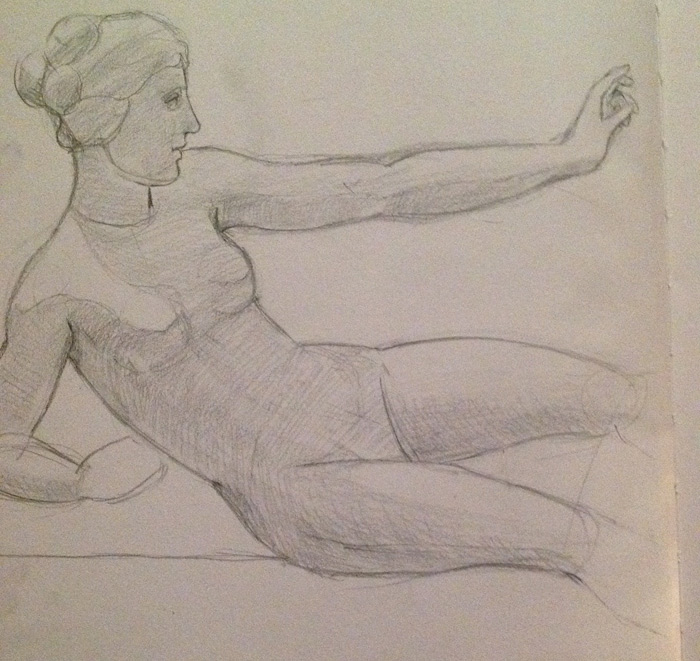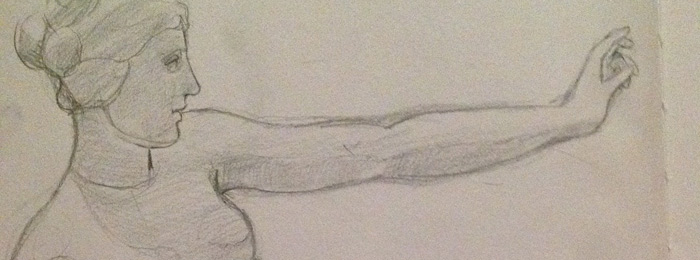Artworks by Angelina, Drawing Academy student
Hello, this is Angelina.
Can you help me with my drawings? I’ve made two drawings from life, including a statue from the art museum. I am having difficulties with grouping the shadows and shading the fabric. Any advice would be helpful.
Thank you


Hi Angelina,
Many thanks for your questions.
I like your drawings and it is great that you draw from life. You are on the right path; just keep drawing more from life; with practice your skills will get better and better.
Now, let’s talk about shading.
In the sculpture drawing, the whole figure is rather gray. Sometimes less is more, and your artwork would look better and fresher if you marked only the deepest tones and left mid-tones out. When rendering tonal values, you need to decide where the darkest place in the whole artwork would be. All other values will be grades of lighter tones up to the white of paper.
If you want to render tones of the whole figure, even mid-tones have infinite gradations from dark to light, so that requires a good deal of analysis and comparing tones of different areas of a sculpture to each other. Seeing gradations of tones comes with practice.
The same rules of tonal rendering apply to fabric. You need to see the big areas of light, mid-tone, and shadow as well as gradations within each area.
Tonal rendering goes gradually, layer by layer, from the darkest to lightest tones, like developing a traditional photograph in a dark-room.
Your challenge with rendering fabric comes from the same problem you have when rendering simpler objects like bowls of fruit, for example.
In your still life, the bowl is a cut-out of only two tones with a bold border between them. I bet this is not the way you actually saw that bowl in real life. Such an approach is an extreme simplification of tonal rendering. Yes, it suggests the shape of the bowl, but by using it you would face greater difficulties when rendering fabric.
You probably have learned from somewhere that blocking the shadow area in one go is the way to render values. Many art ateliers use this method extensively. Such simplification is suited for beginners who need to learn to see big areas of shadow. The downside of this approach is a one-tone gray figure, like your statue example.
When you render the big area of shadow in a single tone, this area combines core shadows, form shadows, and accents altogether. For terminology, please see the image below:

Blocking shadows is good, but separation of light and shadow should be in your mind more than on paper at that step. Yes, you can combine and unite big areas of shadow, but only when you decide on paper what the darkest areas are, so a hierarchy of tones is maintained throughout the whole rendering process.
When rendering tonal values, your artwork should look complete at any given moment. It might not be finished but complete with clear indication where the darkest shadows are – form shadows and core shadows; then you need to progress to mid-tones, dark halftones, middle halftones and light halftones in sequence, constantly deepening shadows as well, so the contrast between different values stays the same while the whole artwork gets darker and darker, layer by layer.
Depending on your creative task, you may not even get to the stage of rendering light and local light areas, unless you intend to make it a fully rendered piece of art with only highlights staying untouched.
Once again, thank you for your wonderful artworks.
Best regards,
Vladimir London
Drawing Academy tutor
To learn human anatomy fast, visit the Anatomy Master Class »
To learn professional drawing techniques,
Enroll in the Drawing Academy Course
Pay once - Enjoy forever!
Only $297






Good drawings and very good and detailed answer! I’m learning a lot on this website